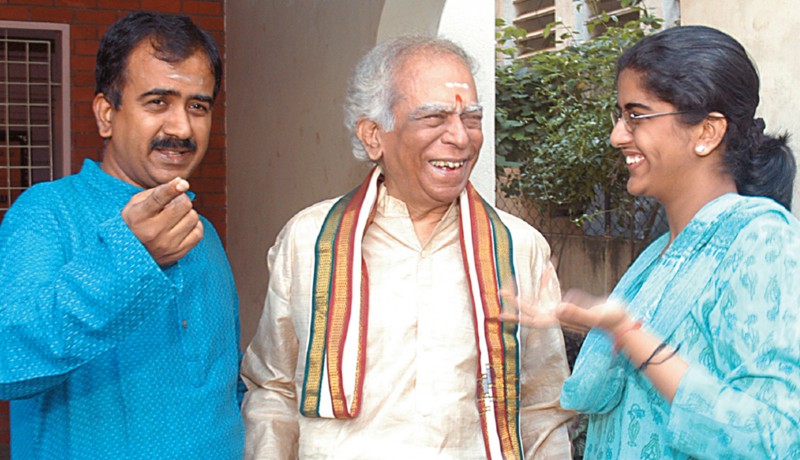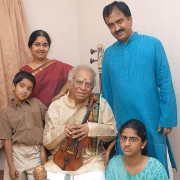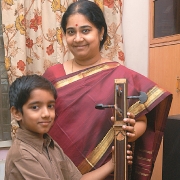
People

Violinist Lalgudi Jayaraman’s children and grandchildren carry on his musical tradition with passion and flair, writes Padmini Natarajan
A melody comes into my mind, anytime, anywhere, in the night and I jot it down, otherwise it will slip away. Then the melody takes over my thoughts and demands to be composed. Sometimes a composition flows beautifully, at others it refuses like a recalcitrant child to settle into a pattern. It has a life of its own and has to be polished and played many times until it can be performed.
— Lalgudi Jayaraman
Enter violinist Lalgudi Jayaraman’s simple home in bustling T Nagar in Chennai and you are bathed in sound — the bow deftly picks up the seven notes on the violin; voices run up and down the scales in concord; and children, grandchildren, students and other musicians flit in and out chattering excitedly. This is not just a house but a shrine to music where three generations live — and play — together in harmony. Conductor of this family symphony is the prolific 77 year-old Jayaraman revered in the world of Carnatic music for his melody, rhythm and technique. By contrast, his wife Rajalakshmi is a quiet presence, welcoming visitors with warmth but preferring to stay on the sidelines. In the music room adorned by large portraits of three generations of his forefathers, Jayaraman holds court with his students, most notable of which are son G J R Krishnan and daughter Vijayalakshmi, both in their 40s, and grandchildren Samyuktha, 19, and Arjun, 8.
Music runs in their blood. Jayaraman’s ancestor was a disciple of Saint Thyagaraja, a composer, philosopher and cultural icon in southern India, who preached salvation through devotional music in the 19th century. His father, V R Gopala Iyer, was also a teacher, and taught the young Jayaraman, who began his musical career at the age of 12 as an accompanying violinist. As his knowledge of the nuances of Carnatic music and its different baani or styles grew, he went on accompany renowned vocalists such as G N Balasubramanian, Madurai Mani Iyer and Chembai Vaidyanathan.
This rich and varied concert experience soon became the background for establishing himself as a solo violinist. Judiciously combining tradition with innovation, Jayaraman evolved a new technique of violin-playing — Lalgudi Baani — a proportion of melody and rhythm that comes closest to reproducing vocal music, consciously giving emphasis to lyrics and expression of sentiments. He began to compose thillana (a rhythmic coda where syllables are used in a rapid rendition) and varnam (centrepiece in a recital of music) that were a blend of raga, bhava (feeling), rhythm and lyrical beauty.
Jayaraman, a Padmashri and Padmabhushan, was the first musician to bring international attention to the Carnatic style of violin playing — in 1965, violinist and conductor Yehudi Menuhin presented him with an Italian violin at the Edinburgh Music Festival. He also introduced a new concept of a musical ensemble with violin, venu (flute) and veena in 1966. Composing in four languages — Tamil, Telugu, Kannada and Sanskrit — his compositions became popular with Bharatanatyam dancers and singers. In fact, to honour him as a ‘living legend’, some of the most renowned dance schools in Chennai — Bharathalaya, Chidambaram, Kalakshetra — came together this October to pay tribute to his talent in the show Lalgudi Margam, held at Chennai’s Music Academy, which featured his compositions. And his stage shows continue to receive rave reviews.
“My sister Vijayalakshmi and I learnt the niceties of performing on stage from my father,” says son Krishnan, a recipient of the prestigious Kalaimamani Award from the Tamil Nadu government for excellence in art and literature. “My father is a complete and composite guru.” The siblings also learnt from their grandfather Gopala Iyer. “Both Appa [father] and Thatha [grandfather] were equally strict and we learnt from them individually, and with the other students,” recalls Vijayalakshmi. “Appa was an excellent critic and never played favourites. Sometimes he taught certain techniques or rare kriti [longer format of a Carnatic music song] to other students and we came to know of it only when we heard them sing or play. He insisted on students singing the raga and lyrics first and getting to know the nuances of the language before playing. The playing of the violin was not merely a display of technique — the technique was used to enhance and enrich the kriti. But the best lesson he taught us was to never compromise on quality.”
Jayaraman taught them another valuable lesson — to bring their own creativity to the music. In fact, Krishnan, who lives with his father, has gone beyond the classical ambience of the cutcheri (recital) — he conducted a Carnatic symphony with more than 20 modern instruments at the Singapore Arts Festival in 2005. “I’d love to repeat the performance in India if we get sponsors,” he says. “Globally, Indian music is only associated with the sitar and tabla. My peers and I are trying to give the world an opportunity to listen to our style of music.”
This includes Vijayalakshmi who travels all over the world for concerts and recitals, with her family and alone — she doesn’t just play the violin; she also sings. “I am equally comfortable playing the violin or singing,” she says. “Singing came to me because of my father’s style of playing, which is very vocalised. Along with playing the violin, I had to sing along. I never stopped.” She believes change is a natural and continuing process but that it shouldn’t be used as licence to dilute tradition. “Presenting your art with freshness, within the framework of tradition, is the challenge of a talented player.”
The siblings showed their talent — and celebrated their lineage — at a concert arranged by Daksinachitra Music Academy this July called Parjanya – The Rain Cloud. Krishnan and Vijayalakshmi explored the different moods of rain — soft raindrops, the drizzle followed by the fury of the cloudburst — through swara, alpana and the imaginative use of percussion. They also performed together on the soundtrack of Sringaram – Dance of Love (2005), a film by Sharada Ramanathan based on the lives of the Devadasis that won three national awards in music, cinematography and choreography — the music was composed by Lalgudi Jayaraman; the first time he scored for a film.
“Interacting with my father gives us new perspective to familiar perceptions of music,” says Vijayalakshmi. “That is the wonder of imbibing his knowledge. Now, my son Arjun is learning how to play the violin.” The eight year-old who studies in third grade takes lessons from his mother — but idolises his uncle. “Maybe it’s male bonding!” she quips. Meanwhile, Krishnan’s daughter Samyuktha, who studies computers and accountancy in college, learns from her grandfather. “When she performed with my father and I at the Krishna Gana Sabha Golden Jubilee celebrations in 2006, it was reinforcing a tradition,” says Krishnan. The venue too has special significance. “The Krishna Gana Sabha gives an artist the respect and freedom to experiment with music,” explains Vijayalakshmi. “All my father’s disciples, including Anna and I, have performed first at the Sabha because of my father’s long-time association with it.” Jayaraman is proud of his musical family. “My three sisters were involved with music and now another generation is taking over,” he says. “Youngsters are intelligent and grasp musical nuances quickly.” But he is quick to add, “They also tend to forget them. In our time, we practised a piece until it was hammered into us like a nail!” Alas, concentration is hard with the continuous assault of noise pollution.”
In the background the mixer whirrs laboriously from the kitchen and an auto rickshaw raucously blows its horn on the street outside. Still, in the Lalgudi home, the music plays on.
Photos: V Ramesh Featured in Harmony – Celebrate Age Magazine December 2007
you may also like to read
-
For the love of Sanskrit
During her 60s, if you had told Sushila A that she would be securing a doctorate in Sanskrit in the….
-
Style sensation
Meet Instagram star Moon Lin Cocking a snook at ageism, this nonagenarian Taiwanese woman is slaying street fashion like….
-
Beauty and her beast
Meet Instagram star Linda Rodin Most beauty and style influencers on Instagram hope to launch their beauty line someday…..
-
Cooking up a storm!
Meet Instagram star Shanthi Ramachandran In today’s web-fuelled world, you can now get recipes for your favourite dishes at….









